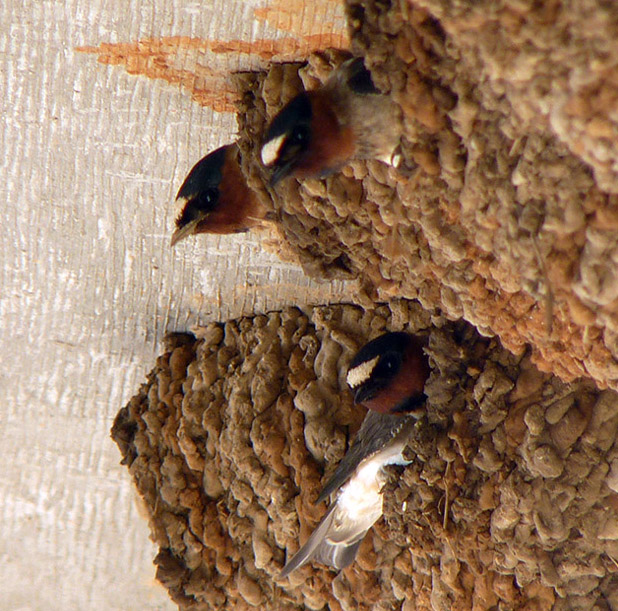
The Cliff Swallow (Petrochelidon pyrrhonota) is a nesting bird everywhere in Oklahoma, but rarer in the eastern part of the state. Breeding bird surveys show a 9.8% relative abundance increase in populations for central Oklahoma from 2001-2011. This swallow makes wonderful use of the underside of highway bridges for nesting habitat, no doubt now its main nesting habitat in the state. Some of the flocks under bridges number in the hundreds or more: The largest nesting flock I could find in the G. M. Sutton Species’ Summaries [1982] was estimated at 15,000 birds, seen in Mayes County on July 18, 1969, by members of the Tulsa Audubon Society. Stopping to observe one of the large flocks that nest under bridges can be quite a sight to see.
At nesting time these swallow congregate at water puddles and other water spots that have mud along the shore. They fly in, land, and with wings aquiver and held above their heads, they proceed to gather mud with their bills with which to build their jug-like nests. The quivering wings may be a type of breeding behavior as pairs will sometimes mate while at these water holes, but perhaps the birds are just being sure not to cake their wings with mud. Dr. Sutton, in his book Oklahoma Birds (1967) pointed out that you do not find this bird nesting where there is no mud nearby for building nests. This, of course is a logical conclusion, but I thought it interesting that “Doc” had taken the time to specifically note this behavior, ruling out that the birds are traveling very far for the mud.
Within the last year I heard about a construction company being charged for destroying Cliff Swallow nests, something over a hundred nests, I believe it was, while they were working on a bridge to make it bigger and safer; the construction company did not dispute the claim. I have not heard how the suit turned out (if it has) but I was rooting for a minimum, or no, penalty in this case. The reason to root for the construction company is that most populations of Cliff Swallow ARE under manmade bridges: if construction companies had not built the bridge in the first place, there would be no problem—and no birds. Such a lawsuit, I believe, is counterproductive, because no doubt there will be even more Cliff Swallows after the bigger and safer bridge is built. Sometimes, by pursuing conservation to the “nth” degree of the law in marginal cases, I think we as citizens concerned about wildlife do a disservice to our “cause.”
Speaking further about laws and birds, sometimes laws are amended for the better in complicated situations and the following, I believe, is a great example of that. Native Americans petitioned to have laws changed so that they could keep in captivity injured, non-releasable birds of prey. In addition Native Americans are allowed to use any feathers molted by these caged birds so that the feathers can be used during Native American religious ceremonies. This is a win-win situation, and a good example of how the law can be amended for the good of all involved, including the birds.
I have an additional example where I think laws could be improved. The average citizen cannot pick up birds that are roadkill or windowkill so that these birds can be turned over to museums or other appropriate scientific entities. Allowing people to salvage accidentally killed birds would help fill legitimate scientific needs of museums, resulting in less need to purposely kill birds for scientific study. Anyway, I point out this example as being an area where we could help preserve birds, if we as a society are sophisticated enough and persistent enough to make wise choices in complicated situations.
One problem I cannot come up with any prospective positive steps is curtailing Brown-headed Cowbird parasitism: these birds deposit their eggs in other birds’ nests, which then disrupts the nesting of the host bird, to the usual detriment of the hosts’ young. Quite a number of birds that now, or formerly, nested in central Oklahoma are reduced or no longer considered nesting species in our part of the state, likely due to cowbird parasitism. One example is the Yellow Warbler. In the 1960s, and perhaps later, I would see Yellow Warblers in trees below the Lake Hefner dam that were no doubt nesting. I have seen no Yellow Warblers in the breeding season in central Oklahoma for many years. It would be nice if we who recognize the problem could pull cowbird eggs from hosts’ nests, but pulling a cowbird egg every now and then doubtless would do little to solve the overall problem. Personally, however, I believe many of us would feel better about pulling such eggs as small, positive acts of conservation. Now where was I on the Cliff Swallow?
